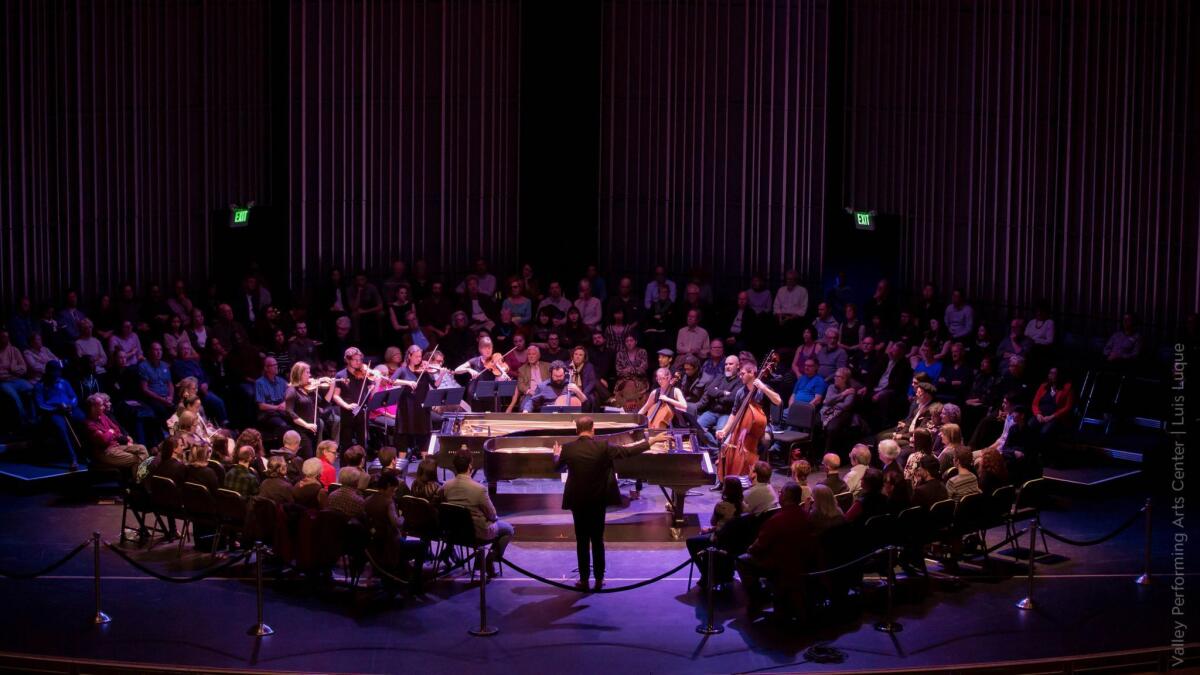Review: A different way to experience John Adams’ music: Sitting onstage, next to the musicians

Christopher Rountree conducts wild Up in a tribute Thursday to John Adams at Valley Performing Arts Center, where the audience sat on the stage with the musicians.
- Share via
John Adams turned 70 on Wednesday. His publisher, Boosey & Hawkes, indicated there were no performances of his work that evening. Perhaps the world wanted to give him a break among the more than 500 performances he is getting this season.
European capitals such as Berlin and London are offering tributes. America’s orchestras are, from coast to coast, Adams-centric, with the Los Angeles Philharmonic and San Francisco Symphony leading the cheering section for an essential West Coast composer.
Thursday night at the Valley Performing Arts Center in Northridge, however, a smaller and far feistier orchestra, wild Up, paid the birthday boy electrifying and uniquely L.A. notice. Although Adams left his native New England for the Bay Area nearly half a century ago, he has not been able to escape the lure of L.A., nor we of him.
His partner in operatic crime, Peter Sellars, lives here. Adams, who serves as creative consultant for the L.A. Phil, has written major pieces for Esa-Pekka Salonen and Gustavo Dudamel. Grant Gershon, music director of the Los Angeles Master Chorale, is another close Adams colleague. So is L.A. pianist Gloria Cheng.
Indeed, you need not look very far for a shared sensibility among L.A. born and raised conductors, with Michael Tilson Thomas, David Robertson and Leonard Slatkin among the composer’s most devoted and persuasive champions. Add to that list the next generation with Christopher Rountree.
The 33-year-old founder and music director of wild Up describes himself in his program bio as being at “the intersection of classical music, new music, performance art and pop.” Thursday, he told the VPAC audience that it all started with hearing a piece by Adams on the radio when he was 14. Having no idea what kind of music it was or that anything like Adams’ music existed, he was moved to follow its lead.
That led to a program Thursday titled “Adams/Punk Rock/Player Piano,” meant to show some of the unlikely underlying sources of Adams’ work. But the real value of the program was its startling illumination of not just what Adams wrote but he has wrought.
The performers were on the VPAC stage, and so was the audience, looking out at the darkened, empty hall. Our perspective was the musicians’ perspective. We all heard the balances a little differently depending upon whom we sat nearest to, just like performers do. Immersive art is all the rage, and here for good reason. Rountree happens to be a very wound-up conductor, and the intensity of the musicians proved incredibly visceral, making everything that was played feel fresh and immediate.
One of the aspects of Adams’ style that doesn’t get enough recognition, Rountree told the audience (wild Up provides neither printed program nor notes), is the composer’s use of space, the way the music implies a depth of field. For wild Up pianist Richard Valitutto, it was Adams’ interest in rags and machines (of the musical sort). That early perspective was used to introduce Adams’ two piano “Hallelujah Junction,” originally written for Cheng and Gershon and played here by Cheng and Valitutto.
But first Ives’ “The Unanswered Question” was offered by strings on stage, with solo oboe on one side of the balcony seats and a wind quartet on the other. When an unanswered cellphone buzzed, vibrating the stage floor, it felt, in this mysterious open acoustic space where anything could happen, like Ives on the line.
Valitutto played a William Bolcom “ghost rag” with charming ease. In the last movement of George Antheil’s mechanistic First Violin Sonata, the pianist and violinist Andrew Tholl gave the impression of a violin trapped in the gears of a haunted, manic player piano.
“Hallelujah Junction,” premiered at the Getty Center in 1998, took a while to catch on, but now piano duos play it regularly, and Adams has said he considers it his best piece. (It’s not, but that doesn’t lessen its value.) The composer even titled his memoir “Hallelujah Junction.”
But there is nothing like hearing Cheng and Valitutto perform close up and with passionate attention to detail. In the normal concert hall setting, a listener can be transfixed by the ear-ringing resonances of two pianos playing ferocious repeated rhythmic figures in and out of phase. Nearer the strings you get inside the inner workings of piano along with the resonance. For a bit of history, Cheng and Gershon will reunite for a performance on March 4 at UCLA as part of an Adams day on campus.
After intermission Rountree turned to an Adams chestnut, “Shaker Loops,” the 1978 work in which the composer found his voice, in its original version for seven strings. But this was an original performance in another sense of the word.
Each player brought something revelatory to the familiar work. A violin could sound more like a flute than ever; a bass fiddle, like a bass drum. When orchestrated for strings, “Shaker Loops” came to be seen as the piece that put a friendly face on Minimalism. In fact, Rountree, who conducted a technically sensational wild Up as though it were a punk rock band, put transgressive makeup all over these looping phrases.
Two exuberant orchestrations of actual Deerhoof and Dog Faced Hermans punk rock songs that ended the evening seemed almost, but not quite, tame in comparison. These wild Up post-Adams party favorites never fail to leave an audience wanting more. After “Shaker Loops” they failed like never before.
More to Read
The biggest entertainment stories
Get our big stories about Hollywood, film, television, music, arts, culture and more right in your inbox as soon as they publish.
You may occasionally receive promotional content from the Los Angeles Times.











